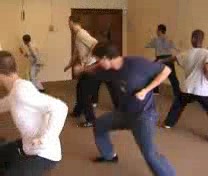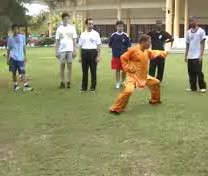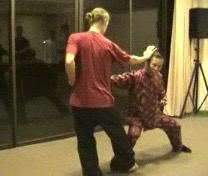HOW DO YOU USE KUNGFU FOR COMBAT?

How do You Use Kungfu for Combat?
Can kungfu be used for fighting? The question itself is odd because by definition kungfu is a fighting art. This means that if you cannot use your kungfu for fighting, then what you practice is not genuine kungfu; it is what past masters called “fa khuen sau theuk” (“hua quan xiu tui” in Mandari) or “flowery fists and embroidery kicks”.
Understandably, those who have devotedly practiced their art for many years would not like it to be called not genuine. Often they would stubbornly and aggressively insist that their art is genuine kungfu despite overwhelming evidence to the contrary; sometimes they even lie to themselves.
But the brave ones would search for ways to make their kungfu combative. We hope the video clips here will be helpful to these brave people, even though they may not want to learn from us. On the other hand we would not want to waste time arguing with those who insist their art is genuine kungfu even though they cannot use it for combat.
How would kungfu practitioners fight? Of course they fight using kungfu pattern! The answer is so logical that the question seems silly. It is like asking how would footballers play football, or how would pianists play the piano. Of course they perform using the techniques and skills they have practiced.
Yet, there are many kungfu practitioners who believe that kungfu patterns are only meant for training, but when they fight they have to use Boxing or Kick-Boxing! This shows what a pathetic situation kungfu has degenerated into.
You may like to know that some people criticize our sparring as unreal, implying that in sparring and fighting, combatants must necessarily hurt themselves, sometimes brutally. It is precisely to prevent such happenings that we train sparring.
Sifu Marcus Santer of Shaolin Wahnam England made an interesting point. He said that before he joined Shaolin Wahnam he had learnt many other martial arts because he wanted to protect himself from being hit, say, once in five or ten years. But in the martial arts he earlier practiced, he found himself being routinely hit twice every week!
It is also interesting to note that some critics feel offended seeing how relaxed we are when we spar! They question whether we have any fighting experience, not realizing that some of us have used our art not only in winning sparring competitions but in coming out safely in actual combat where deadly weapons were used and where the out-come could be serious injury or death. Obviously these critics do not know that the more proficient the kungfu practitioners are, the more relaxingly and elegantly they fight. Novices are tensed and agitated, whereas real masters are calm and relaxed -- in combat as well as in their daily lives.
Without meaning to sound disrespectful, fighting in the West today, upon which these armchair critics base their judgment, is slight compared to fighting in Asia 30 years ago. Attackers did not merely throw wild punches, push you to the ground and kick your head; they came with axes, spikes and even powdered glass, and showed no mercy to their victims. It was barbaric. (Luckily Asia is a lot more civilized today.) If one is not relaxed and calm, he would be finished.
Of course we in Shaolin Wahnam would not brutalize our opponents, but we must be trained to avoid the possibility of such brutalizing happening to us in real fighting. The video clips below show some of such basic training. How do we know the training is effective? We know because we speak from experience.
This is the second part of the Series. The other parts can be accessed by clicking on the following:
Breath Control in Sequence Training

Many other people may not believe that we in Shaolin Wahnam can spar vigorously for more than an hour, yet are not out of breaths. If you examine the video clips on sparring found later on, you will find that the course participants are not panting. If you attend an intensive Shaolin Kungfu (or Wahnam Taijiquan) course, you will experience this ability yourself. The secret lies in breath control. Here, the course participants use one breath to perform one sequence. At the end of the practice session, they have more energy than when they started!
Breath Control in Set Practice

Earlier, the participants used 36 breaths to perform the basic set, “Lohan Asks the Way”. With systematic training, they can now perform the same set in 4 breaths. Their kungfu movements are therefore much faster, yet they are forceful and not out of breaths. They enjoy a chi flow at the end of their set performance.
Going Back A Step

The concept of “going back a step” is important in our training methodology. If your set practice is unsatisfactory, for example, find out which sequence is at fault and practice that sequence over and over again to master it. If your sequence practice is unsatisfactory, go back one step to find out which pattern is at fault, and practice it over and over again. You may compose a simple sequence with a few patterns you wish to practice on. If you practice a pattern or a sequence over and over again many times, it may become your strong point.
Developing Combat Skills in Pre-Choice One-Step Sparring

It is important to differentiate between developing skills and learning techniques. The training session here is meant for developing skills, especially those of right spacing and right timing. It takes less than 5 minutes to learn the attacking and defending techniques, but many hours to practice them well so that you can use the techniques skillfully.
Applying Kungfu Techniques Spontaneously and Correctly

Participants practice a selected attacking pattern and a selected defending pattern over and over again so that they may apply them correctly and spontaneously. One may argue that in a fight, an opponent may not attack you with this selected pattern. The argument reveals a lack of understanding between techniques and skills. The point here is not to learn how to counter a selected attack with a selected pattern, but using these selected patterns to develop combat skills that can be used for any patterns.
Safety First in Combat and in Life

Many martial artists rush in to attack their opponents without taking care of their own safety. This is probably due to their practicing martial art as a sport where drastic counters like tearing out the opponent's throat or gorging out his eyes are forbidden by safety rules. In Shaolin Wahnam, “safety first” is a cardinal principle, in combat as well as in daily living. This video clip shows the training of “foot adjustment” and “coverage” to implement the “safety first” principle.
Correct Judgment and Instantaneous Change

Having developed skills in right spacing and right timing as well as accuracy of forms and fluidity of movements in the pre-choice stage of one-step sparring, the next stage is self-choice, where the initiator chooses his own attack from a set range of attacks. The responder has to make a correct judgment of the attack. If he makes a wrong judgment, he would change accordingly and instantaneously.
Continuation in Sequence Practice

This video clip shows that the participants have progressed a few stages from the stage shown in the previous video clip. The initiator chooses his own sequence to attack, and the responder must respond accordingly. At the end of the first sequence, they continue to another sequence chosen by the attacker. Only hand strikes are used in this training session. What would happen if an opponent kicks or uses locks and throws. These attacks will be trained in later stages. Notice that by now except for a few occasions when there is some hesitation, on the whole the participants are quite spontaneous in using their kungfu patterns for attack and defence.
Fierce Tiger Speeds Through Valley

Sequence practice is a very important aspect of our sparring methodology. Amongst other benefits, it enables kungfu practitioners to spar or fight without worrying about which technique to use next. It is one of the secrets to the spontaneous application of kungfu for combat. This video clip shows the course participants practicing the attacking mode and the defending mode of Sequence 5, called “Fierce Tiger Speeds Through Valley”. This sequence, when applied skillfully, manifests the “press tactic” in combat.
Combat Application of Fierce Tiger

After being familiar with the sequence, the participants put it into combat application. The uninitiated may argue that since in real fighting an opponent does not follow a fixed sequence, it would be useless to practice sequence sparring. This argument is due to a lack of understanding combat training methodology. Throughout kungfu history, sequence sparring was crucial in training practitioners to fight. In fact it is still extant today in what is commonly known as “two-men set”, a term that is inappropriate as it gives a misleading connotation. Today many people perform “two-men sets” for demonstration, missing the original purpose for combat training.
Dark Dragon Draws Water

Here the participants practice the sixth combat sequence called “Dark Dragon Draws Water”. Notice that after just a day of training, the participants are more fluent in both their attacks and defence. This is possible because they have spent much time in basic training in such areas like chi flow, stances, footwork fluidity of movement and six harmonies. Notice also that they are not tired or out of breath, even though they have been sparring vigorously. But what would happen if an opponent attacks them out of sequence. This will be taken care of in other stages of combat training, in stages like “modification”, “external change” and “internal change”.
Starting Later Arriving Earlier

This is Sequence 7, called “Chop the Hua Mountain”. In the thrust punch, for example, the uninitiated looking at a fixed picture of the combat situation, may think that Grandmaster Wong is too far from his target. But actually Grandmaster Wong's punch could penetrate the opponent's heart, hence it is called “chuin sam choi” (Cantonese pronunciation) or “penetrating heart punch”. Steve successfully avoids the “penetrating heart punch” by shifting his body backward without moving his feet. As he counter-attacks, he finds himself being hit instead, because Grandmaster Wong employs the tactic of “starting later arriving earlier”. Grandmaster Wong explains that he deflects, not blocks, Steve's chopping attack. Had Sifu Wong blocked, his arm could be fractured by Steve's chop.
LINKS
Courses and Classes
